Japan
Wood Products Prices
Dollar Exchange Rates of 10th
Dec
2023
Japan Yen 145.00
Reports From Japan
GDP revised down
Japan's economy contracted at an annualised 2.9% in the
July-September quarter from the previous year, worse than
the initial estimate of a 2.1%. On a quarter-on-quarter
basis, GDP shrank 0.7%, compared with the initial 0.5%
drop reading and a median forecast for a 0.5% fall.
Private consumption, which makes up over half of GDP,
dropped 0.2% as rising prices of energy and household
goods eroded household sentiment. Inflation is a very
negative factor because what wage growth there has been
is more than offset by rising prices.
With inflation being above the Bank of Japan’s
target of
2% for more than a year the public find it difficult to
accept that the inflation goal has not yet been achieved.
See:
https://english.kyodonews.net/news/2023/12/993f488b958b-update1-japans-economy-shrinks-29-in-july-sept-revised-down.html#google_vignette
The Bank of Japan’s (BoJ) latest Tankan survey of
business sentiment shows large Japanese manufacturers
have become more optimistic over the past three quarters
despite many of the economic indicators pointing to
economic contraction. An index of sentiment among
Japan’s major manufacturers rose in December, the third
straight quarterly gain. The quarterly tankan survey
considered a leading indicator of medium term business
prospects.
The December survey reported sentiment among major
non-manufacturers rising for the seventh consecutive
quarter driven by the recovery of international tourism and
a resurgence domestic travel.
See:
https://www.boj.or.jp/en/statistics/tk/index.htm
and
https://www.japantimes.co.jp/business/2023/12/13/economy/boj-tankan-survey-business-mood-improves/
Machinery Orders in October, 2023
Private-sector machinery orders, excluding volatile ones
for ships and those from electric power companies,
increased a seasonally adjusted by 0.7% in October.
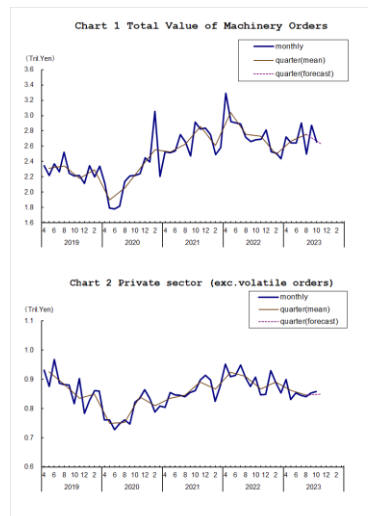
Source:
https://www.esri.cao.go.jp/en/stat/juchu/2023/2310juchu-e.html
Cash payouts and tax cuts to aid household finances
The government has adopted a 13.20 trillion yen (US$90
billion) extra budget for the current business year to March
2024 to ease the burden on households from rising prices.
Low income households will receive 70,000 yen in a
hand-out and subsidies will be continued to lower fuel
costs until next spring.
The economic package also includes a temporary tax
cut
of 40,000 yen per person that will be implemented in the
next fiscal year. The tax reduction has been criticised by
opposition parties.
See:
https://asia.nikkei.com/Economy/Japan-enacts-13tn-yen-FY2023-extra-budget-for-inflation-relief
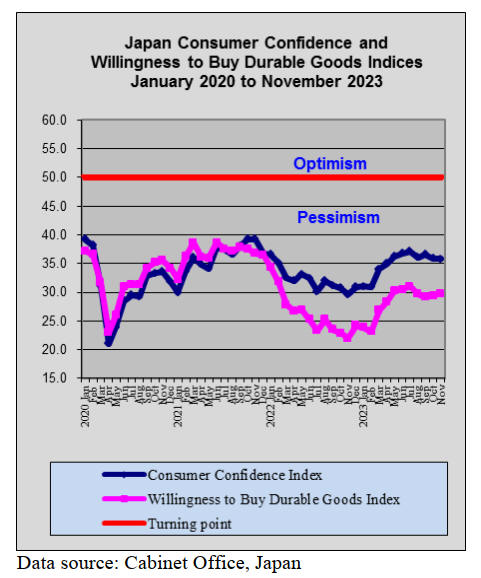
Scrap-and-rebuild cycle doubles emissions from
home
renovation
The traditional system of demolishing homes after around
30 years and then rebuilding rather than renovating the
existing home is now being reassessed given concerns
over sustainability and the high contribution to green
house gas emission in the construction sector.
Refurbishment of homes is becoming more popular mainly
because construction costs for new residences have risen
and because the government is promoting the longer term
use of existing properties through renovation. A recent
article says the scrap-and-rebuild cycle could produce
nearly double the emissions of renovations.
A joint study Sumitomo Realty and Development and
Musashino University attempted to determine how
renovating houses could reduce carbon dioxide emissions
compared with building new houses from scratch. It was
reported that renovating an entire home could cut around
47% of emissions from the traditional ‘scrap and rebuild’
process.
See:
https://www.japantimes.co.jp/environment/2023/08/27/sustainability/japan-scrap-build-sustainability/
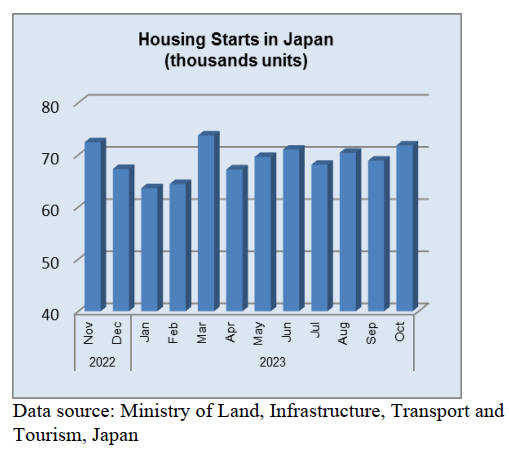
Yen surge on remarks by BoJ Governor
The yen rose against the US dollar to its highest level in
four months in mid December, briefly strengthening to
around 141 for the first time since August. The brief yen
surge came over a remark by Bank of Japan Governor
Ueda Kazuo when he said the situation in Japan “will get
more challenging in the year-end and early next year”
fueling speculation that interest rates may be lifted.

Import update
Assembled wooden flooring imports
Of the various categories of assembled flooring imports in
October HS441875 was the largest, accounting for close to
70% of the total value of assembled flooring imports
followed by HS441879. The main shippers of HS441875
in October were China 49% the EU, Vietnam, Malaysia,
Thailand and Indonesia.
The value of Japan’s October imports of assembled
flooring (HS441871-79) dropped slightly (4%) compared
to the value of September arrivals. Year on year the value
of October assembled flooring imports fell around 16%. In
the first 10 months of 2023 Japan’s imports of assembled
wooden flooring (HS441871-79) were around 15% below
those in the first 10 months of 2022.

Plywood imports
After two months of expansion there was a correction in
the volume of plywood imports by Japan. The volume of
October imports stood at 124,969 cu.m, down around 11%
month on month and down 9% year on year.
Despite the October dip in imports in the 10 months to
October 2023 plywood imports rose almost 50% from the
same period in 2022.
Imports from China rose over 80% in 2023 from a year
earlier, the volume of imports from the top two suppliers,
Indonesia and Malaysia, were up over 50% in the first 10
months of 2023 compared to the same period in 2022,
however, the volume of plywood shipped to Japan from
Vietnam in the first 10 months of 2023 was little changed
from a year earlier.
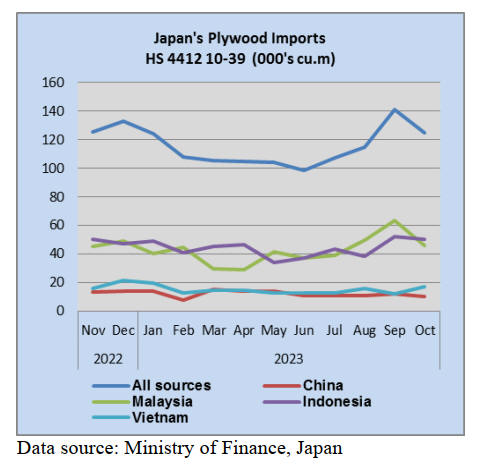 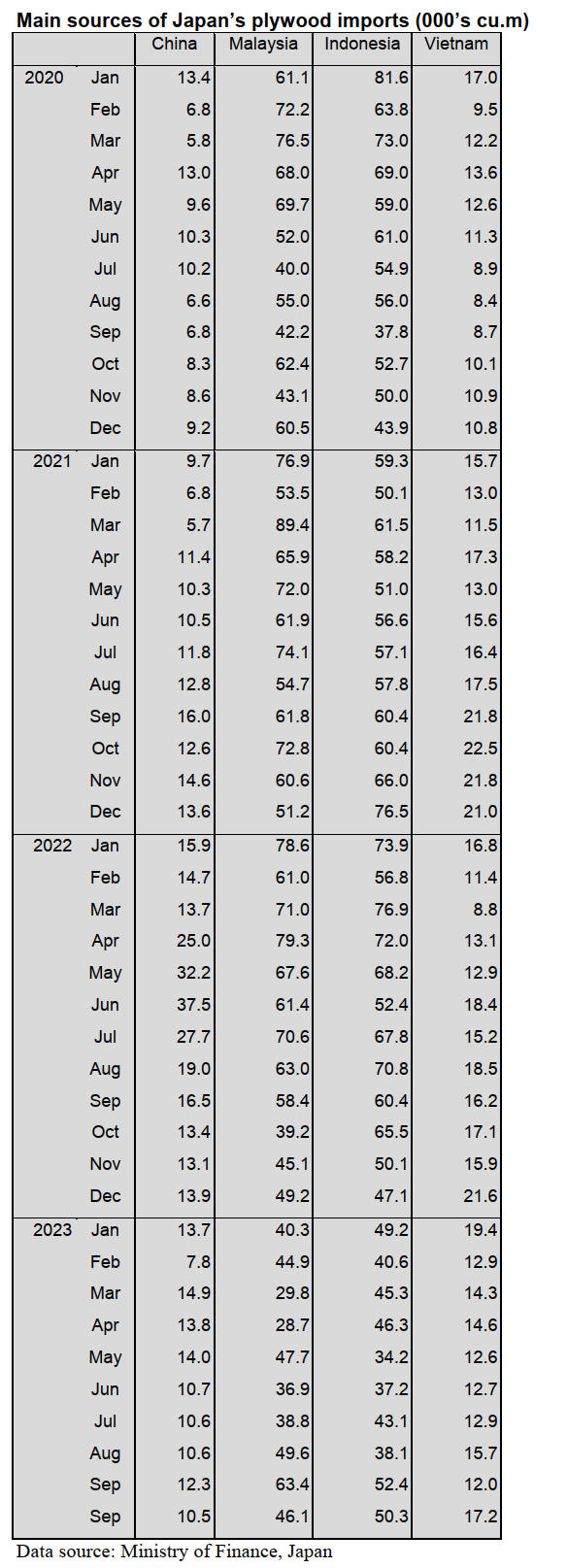
Trade news from the Japan Lumber Reports (JLR)
The Japan Lumber Reports (JLR), a subscription trade
journal published every two weeks in English, is
generously allowing the ITTO Tropical Timber Market
Report to reproduce news on the Japanese market
precisely as it appears in the JLR.
For the JLR report please see:
https://jfpj.jp/japan_lumber_reports/
Supplementary budget of fiscal year 2023
The Ministry of Agriculture, Forestry and Fisheries
announced the supplementary budget of fiscal year 2023.
140.1 billion yen will be included in the budget.
The total budges is 818.2 billion yen to eliminate
dependency on imports, to mitigate an influence of high
prices of commodities, to enforce policies for TPP, and for
disaster prevention, disaster risk reduction and national
resilience.
45.8 billion yen will be used for strengthening in
international competitive power at forestry and wood
industries and for expand demand in Japan. For details,
strengthening in production base of forestry and wood
industries, promoting digitalization and innovation in
forestry industry, supplying more structural lumber, using
more structural lumber, increasing demand and supply for
lumber and export.
6 billion yen will be used for preventing hey-fever. Cedar
artificial forests will be reduced by 20 % in 10 years later.
33.2 billion yen is added to recovery and reconstruction
from the heavy rain disaster occurred during May to July,
2023. 26.8 billion yen is added to avoid the damages of
driftwood, debris flows and hillside collapses from the
earthquakes or heavy rains. 17.2 billion yen is required for
thinning, reforestation, establishment or improvement of
mainlines and infrastructure facilities.
There will be a support of energy saving on production
facilities for mushroom producers because the price of fuel
oil and raw materials has increased. Also, there will be a
support for producing wooden biomass fuels. 2 billion yen
will be added to the supports. Another support is 100
million yen for securing next generation in forest industry
and preventing damages from wild animals.
The Ministry of Land, Infrastructure, Transport and
Tourism also announced the supplementary budget of
fiscal year 2023. 210 billion yen will be included in the
budget for supporting energy saving houses. The total
national expense is 2.5 trillion yen.
The five aims are below.
To protect people from high prices of
commodities.
To raise salaries in regional towns and small and
medium-sized businesses.
To promote people to invest in Japan
To stop population decline and promote social
change
To ensure peace and safety from disaster
prevention and disaster mitigation by national
resilience
The total budget for energy-saving houses is
421.5 billion yen from The Ministry of Land,
Infrastructure, Transport and Tourism (MLIT),
The Ministry of Economy, Trade and Industry
(METI) and The Ministry of the Environment
(MOE).
There will be support for remodeling houses to be
energy-
saving. 210 billion yen is from MLIT. 135 billion yen is
from MOE for high thermal insulation windows. 58 billion
yen is from for high performance water heaters and
18.5billion yen is for remodeling existing rental
apartments to be energy-saving rental apartments from
METI.
Log markets in Fukushima Prefecture
The price of cedar logs for posts and cypress logs for sills
have skyrocketed in the middle of September and the
prices are still high because there have been less logs. The
log markets were held in Octobe and November but there
were not a lot of logs as usual and the log price were very
high.
In the beginning of November, the price of 3m cedar log
was around 17,000 yen, delivered per cbm and it is 3,000
yen more than the previous month. The highest price was
18,000 yen, delivered per cbm.
Once, the price of cedar log was under 10,000 yen,
delivered per cbm, during the rainy season to the summer
season. Therefore, loggers reduced cutting down the trees
and some of them changed their businesses to cut down
trees for wooden biomass fuels or to cut down trees
around steel towers or forests for solar power plants by
contract. As a result, the cedar logs for posts started to rise
after the holiday in the middle of August. There was also
influence of damage by the typhoons in September and
volume of logs decreased at the markets.
The price of 3 m cedar log for posts rose to 10,000 yen,
delivered per cbm at the end of August and then the price
rose by over 2,000 yen every month after August. The
price of 4 m cedar log also rose to 10,000 yen, delivered
per cbm in the middle of September. Then, the price was
12,000 – 13,000 yen, delivered per cbm at the end of
September.
November, the price kept rising to 13,000 – 14,000 yen,
delivered per cbm. The price with good quality cost
15,000-16,000 yen, delivered per cbm. The price of 2 m
cedar log with low quality had been around 7,000 yen,
delivered per cbm until the beginning of October and the
price rose to 9,000 yen, delivered per cbm in November.
There were a lot of inquiries for cypress lumber as
substitution of Doulgas fir lumber. The price of 4 m
cypress logs for sills rose to 20,000 yen, delivered per cbm
the end of September from 15,000 – 16,000 yen,
delivered per cbm, during the rainy season to the summer
season.
The price rose again in October and it was 24,000 yen,
delivered per cbm. The highest price of 4 m cypress logs
for sills is 29,000 yen, delivered per cbm and of medium
sized cypress logs for sills is 27,000 – 28,000 yen,
delivered per cbm. Also, the price of 3 m cypress logs rose
to 22,000 – 24,000 yen, delivered per cbm in November.
Domestic lumber and logs
The log price recovered and lumber is in short supply so
supply and demand is balanced. There had been less logs
until summer through the nation but the volume of logs
started to increase in autumn, when the demand for lumber
is the peak season, and there was a huge log and lumber
market held in some areas. Actual demand for cedar and
cypress logs increased because there are not enough
Douglas fir lumber. Inquiries for logs rise because it is the
season for cutting down the trees.
In Kyushu region, the price of cypress logs recovered
suddenly because there were not enough logs due to the
torrential rains in summer. 4 m cypress for sills in
Kumamoto Prefecture is around 26,000 yen, delivered per
cbm.
In Chugoku region, once the price of cypress log was
under 20,000 yen in summer but the price recovered in
autumn because there were a lot of inquiries. Consumers
in Okayama Prefecture started to buy cypress logs instead
of Douglas fir logs and the price of cypress logs
skyrocketed to 47,000 yen at the beginning of October.
Now, the price of cypress log is settled down to around
25,000 – 27,000 yen.
4 m cypress log for sills in the northern part of Kanto
region is around 30,000 yen in November. 3 m cedar log
for posts is around 20,000 yen.
There are not enough logs in the northern part of Kanto
region and the price of cedar and cypress lumber has been
bullish. KD 3 m x 105 mm cedar post is around 65,000
yen, delivered per cbm. KD 3 m x 30 x 105 mm cedar stud
rose to 65,000 yen and this is 5,000 yen higher than the
previous month. Cypress sill is 85,000 yen. 4 m x 45 mm
cypress taruki is around 90,000 yen.
Plywood
The price of 12 mm 3 x 6 domestic and structural plywood
has been decreasing slightly. Some plywood
manufacturers started to reduce the price before the
autumn because of sluggish demand and some distributors
started to reduce the price because it was the accounting
period. 12 mm 3 x 6 structural plywood was 1,450 – 1,500
yen, delivered to wholesalers per sheet.
The price decreased by over 50 yen, delivered to
wholesalers, per sheet. 24 mm plywood is 3,100 yen,
delivered to wholesalers per sheet and 28 mm plywood is
3,650 yen, delivered to wholesalers per sheet. These prices
are 100 yen, delivered to wholesalers per sheet, lower than
the previous month.
For imported plywood, the yen was 150 yen against
the
US dollar in November but the price of softwood plywood
is weak so it is difficult to raise the price. 2.5 mm plywood
is 780 yen, delivered to wholesalers per sheet. 4 mm
plywood is 1,000 yen, delivered to wholesalers per sheet.
5.5 mm plywood is 1,200 yen, delivered to wholesalers
per sheet. Structural plywood is 1,800 yen, delivered to
wholesalers per sheet. 12 mm3 x 6 form plywood is 1,990
–2,000 yen, delivered to wholesalers per sheet. At some
wholesalers, the price of 12 mm 3 x 6 form plywood is
around 1,950 yen.
For South Sea plywood, South Asian exporters announced
about its price hike and there is no contracts signed yet.
Inventory of South Sea plywood in Japan is decreasing but
there are not many orders for South Sea plywood from
Japan. In South Asia, 2.4 mm 3.x 6 is US$950, delivered
per sheet. 3.7 mm is US$880, delivered per sheet. 5.2 mm
is US$850, delivered per sheet. 12 mm 3 x 6 painted
plywood for concrete form is US$670 – 680, delivered per
sheet. Plywood form is US$580, delivered per sheet.
Structural plywood is US$560 – 570, delivered per sheet.
Wood biomass in Japan
It has been twelve years since the FIT (Feed-in Tariff) of
renewable energy enforced. Wood biomass power
generation business has some issues which were
unpredicted at that time. The issues are the high prices of
commodities, difficulties in collecting woody fuels and
intensified competition of wood biomass power generation
business.
According to the survey, which Japan Woody Bioenergy
Association held to the members, about 40 % of woody
power generators struggle to operate the wood biomass
power plants as they scheduled. About 17 % of the woody
power generators answered that difficulties in collecting
woody fuels and high-priced woody fuels are the reasons
for not operating the wood biomass power plants
smoothly. The latest issue is a short supply of unused and
domestic logs with low quality.
Since demand for domestic lumber and plywood plunged
this year, supply and demand for domestic logs with high
quality became very low and this situation influenced the
domestic logs with low quality. The price of unused and
domestic logs for fuels in Eastern Japan is 6,000 – 7,000
yen, delivered per ton and the price in Western Japan is
7,000 – 8,000 yen, delivered per ton.
There is a short supply of unused and domestic logs in
some areas because there have been built and permitted
many woody biomass power plant with its output 2,000
kW.
The price of unused chip in Eastern Japan is 9 – 11 yen,
delivered to silos per kilo and the price in Western Japan is
10.5 – 12 yen, delivered to biomass power plants per kilo.
Hokkaido Prefecture - Demand and supply for chips is
not a problem so far because the procurement network is
good. The price of larch logs for papermaking and chips is
16.2 yen, delivered to silos per kilo. The price of Sakhalin
fir logs for chips is 16 yen, delivered to silos per kilo.
Tohoku region - Demand for lumber and plywood
decreased and there are less logs for woody biomass fuels.
The price of unused logs is 6,000 – 7,000 yen, delivered to
chip plants per ton.
Kanto region - The price of unused logs is 6,000 – 7,000
yen, delivered to chip plants per ton with barks. The price
of chips for wood biomass power plants is 9 yen, delivered
to silos per kilo.
Chubu region - The log price for buildings is low and it is
difficult to collect logs. The price of unused logs for wood
biomass power plants is over 10,000 yen, per ton in some
areas in Chubu region but demand for logs for plywood is
now settled down so there is not an extremely short
supply.
Chugoku region - A short supply of fuels for biomass
power plants influences the price of raw materials to rise.
The price of raw materials for fuels in Okayama Prefecture
used to be 5,500 – 6000 yen, delivered to chip plants per
ton. The price in Hyogo Prefecture is 8,500 – 9,000 yen,
delivered to chip plants. The price of unused logs for pulps
without proof in the northern part of Okayama Prefecture
is 8,000 – 8,500 yen, delivered per cbm.
Kyushu region - The price unused raw materials for fuels
in the northern part of Kyushu region is 8,500 yen,
delivered to chip plants per ton and the price in the
southern part of Kyushu region is 8,500 – 9,000 yen,
delivered to chip plants per ton. The price of unused logs
for export is 10,000 – 11,000 yen, delivered to ports per
cbm. The logs for papermaking cost 8,000 yen, delivered
to chip plants per cbm.
|